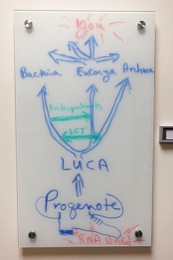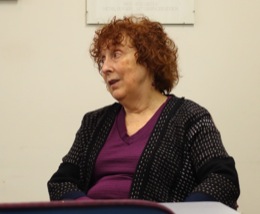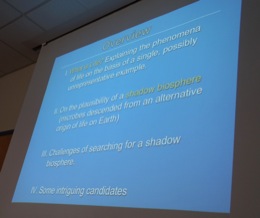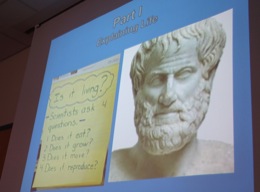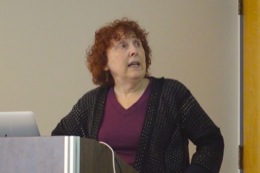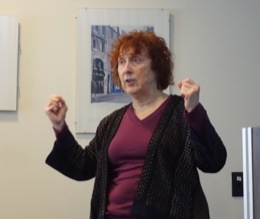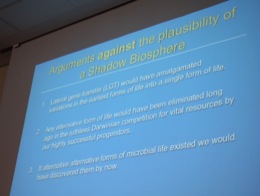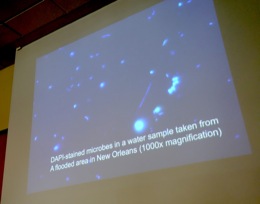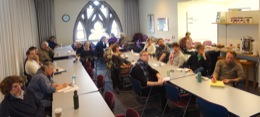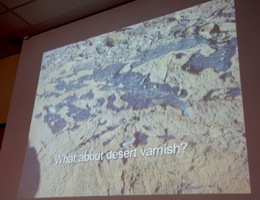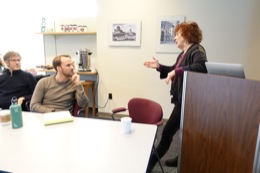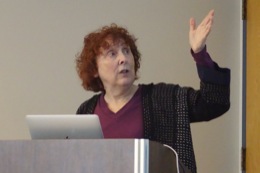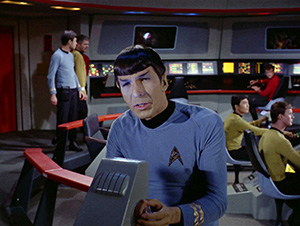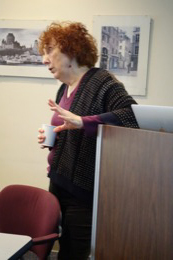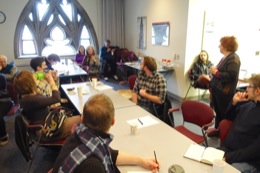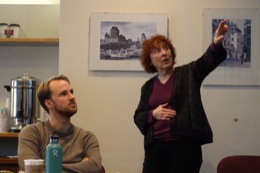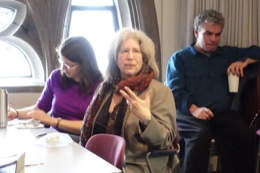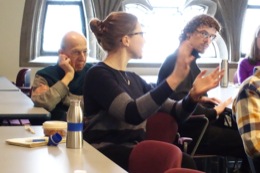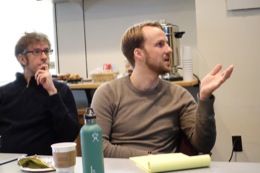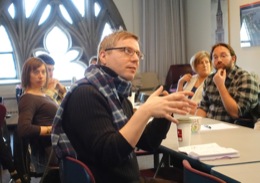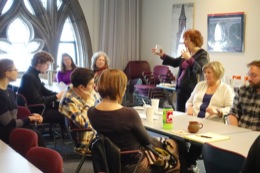
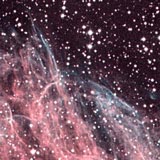
![]()
home
::: about
::: news
::: links
::: giving
::: contact
![]()
events
::: calendar
::: lunchtime
::: annual
lecture series
::: conferences
![]()
people
::: visiting fellows
::: postdoc fellows
::: resident fellows
::: associates
![]()
joining
::: visiting fellowships
::: postdoc fellowships
::: senior fellowships
::: resident fellowships
::: associateships
![]()
being here
::: visiting
::: the last donut
::: photo album
|
Carol Cleland has been a most entertaining visitor this term in the Center. She is best known, I believe, for her work in philosophy of the geosciences and biology. There she explores its outer realms. That means things like astrobiology and the possibility of forms of life wildly different from our common conception. Yet when she arrived in the Center and we first sat down to talk, we homed in fairly quickly on topics in computation. We shared, we discovered, a fascination for another variant form of being: notions of computation other than the conventional Turing computability. Carol has, I found, a Bachelor’s degree in mathematics and a lingering interest in such technical matters. In a short, intense conversation, we ended up with the startling conclusion, “you know, what we just said—-there’s a paper in that!” Today she is giving a lunchtime talk. Her abstract had already intrigued me and, as the talk unfolded, I was pleased to see that it lived up to its promise. Philosophy of science has become more technical and more specialized. I now often find myself lost even in talks in philosophy of physics, one of my core areas. Since I know even less biology, I am commonly quite lost in serious talks in philosophy of biology. That is what I loved about today’s talk. Carol had managed to meld together big and interesting issues in philosophy with advanced technical questions that would normally pass well over my head. We will move through general questions like “What is life?” to Kuhn’s notions of paradigm and anomaly and on to sentences like “PCR amplifies 16s rRNA sequences. . .” that are otherwise obscure to me. The focus of the talk is a simple one. All known life forms share a common structure at the molecular level. It is a highly contingent commonality. There is no necessity in the particular genomic code used by DNA. There is no necessity that all life should be based on just the few, 20 amino acids it uses, out of the many others available. All life shares this common structure because it just happens to be descended from a single common ancestor, Luca. The familiar name is a subterfuge. It is really “LUCA: Last Universal Common Ancestor.” At this point, I decoded what had been on Carol’s glass board outside her office door for over a week. All this means that there is a great deal of contingency in our specific form of life. When we build our conception of life, that conception is tuned to one possibly unrepresentative example. This possibility triggered a brief review of our definitions of life. A few familiar ones flashed across the screen. I’d already seen these decades ago in high school. The definitions required things like having a metabolism and being capable of reproduction. They seemed rather too simple to me, both then and now. Carol had a still dimmer view. None of this would be new to Aristotle. Yet modern science advanced when we broke away from Aristotle. She cited our discarding of the four elements of Aristotle at the birth of modern chemistry. We have to do better than Aristotle. At this moment, my HPS soul was wincing just a little. I could think of several colleagues who would be proud that Aristotle was still current. We press on. Might it be that there are other life forms around us, yet vastly different from the life forms we know? That other world, there but invisible to us, needs a name. Carol had called it the “shadow biosphere.” She had been delighted when the name stuck and spread through the literature. Alas, she lamented, news that she had coined it had not traveled as quickly. This idea is a heterodox idea and, we learned, resisted by the mainstream of biology. Carol is not faint of heart. She had, she assured us, confronted as many biologists as she could to find the reasons for their dismissal of the shadow biosphere. She found three main arguments. They were elaborated and then carefully dismantled. The strongest argument, it seemed to me, was that if there were such other life forms, we would have found them already. That was the argument that Carol disputed most fiercely. We went on a long tour through the methods used presently to detect life. Some were too blunt to discriminate novel lifeforms. Under a microscope, all microbes look alike. Other more sophisticated techniques that tapped into the characteristic DNA structure of life were too closely tailored to our specific type of life. If all that your probe can find are familiar life forms, then that is all you can discover. The tour was quite a tour de force. The arguments against the shadow biosphere were crumbling. However that much is only half the story. Do we have any positive reasons to say that there is a shadow biosphere, populated by exciting, novel lifeforms? That is the part I had been waiting for. Knocking down the opposition is the easier part of the project. Now comes the hard part. It is here that Kuhnian notions entered and Carol began the concluding part of her talk. We only know of familiar lifeforms since our paradigm tells us that is all there is. We are blinded by it. But Kuhnian ideas also tell us where to look if we are to break the paradigm. We need to look for anomalies. They are the harbingers of the new paradigm. Carol then unveiled a list of candidate anomalies. There were unexplained results in Viking experimental tests on Martian soil. There were Phillipa Uwin’s mysterious nanotubes. However the most promising paradigm breaker was the odd phenomenon of desert varnish. Carol speaks fast. But even her fast speech could not mask that she had so much material that we would run over time. After one or two apologetic breaks, she concluded shortly after 1pm. We took a short break. The presentation had been lively. Carol’s enthusiasm for the shadow biosphere was infectious. As one anomalous mystery after another passed over the screen, I could not help but hope that maybe this one was The One. It would reveal once and for all that we had, as hidden neighbors, forms of life beyond our ordinary conception. The notion was tantalizing, as if we were suddenly participants in a wild science fiction story. The famous, half-remembered line in Star Trek suddenly seemed a little more real. “Alien lifeforms detected, Captain.”
That was when the first hesitation crept in. The argument was sounding familiar, but in an unsettling way. The dark thoughts grew and I could not suppress them. Spock would not approve. Yes, the cryptozoologists admit, we cannot be sure that we share the world with Big Foot and the Loch Ness monster. But there are persistent and odd anomalies that no one can otherwise explain. What about those big, strange footprints and the odd sonar echoes? Are we dismissing them in haste? That’s the problem: the evidence remains forever frozen on the edge of the credible, as lingering anomalies. The longer they linger, never quite issuing in the decisive result, the more our doubts grow. As we settled in for question time, I could see it would be an energetic one and that time would be short. Carol favors long, frenetic answers, so I tried to suggest that this might not be the best way now. Sandy’s was the first question. I found that she shared my hesitations. Unlike me, she had no reservations over laying them out. “This is conspiracy theory logic,” she blurted out. “That you didn’t find something isn’t evidence that it is there.” What followed was a boisterous and curiously joyous back and forth. That wasn’t Carol’s point, she explained. She is agnostic on whether there are these other lifeforms. All she wants to establish is that we cannot make a case against them. The issue is plausibility. And then there are those anomalies . . . Sandy had more. Carol had criticized our constricted definition of life. It is tuned to the one example we know. What’s wrong with that, Sandy now wanted to know. We need to name things so we can talk about them. Studying our particular form of life is a worthwhile endeavor by itself, whether its conception is excessively constrained or not. Now it was Carol’s turn for a sharper question: “Is life a natural kind?” she replied? If we don’t pay attention to the unity of the phenomenon, we will fail to grasp it properly. “Natural kind? Natural kind?!!” Sandy was blanching at this intrusion of suspect metaphysics. We were short of time and Sandy was aware that her questions were consuming much of it. She motioned to close the discussion. I felt that this exchange was so precisely targeting the foundational philosophical questions that I did something I never recall doing before. I encouraged them to continue. They did, for a little. Then others entered with further question. There was no loss in the energy of discussion. I promise to everyone in the Center that I cut off any discussion ruthlessly at 1:30pm exactly. We need to know that there is always a definite end when we can escape the room. This discussion was hard to curtail. Carol, not shy of her audience, moved comfortably around the room, fielding questions from the middle of the audience. That makes it hard for me to insert myself. I managed to close discussion at 1:31pm and move to the closing ceremony. John D. Norton
|
